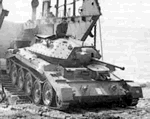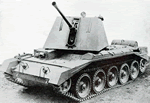Britain's Cruiser Mk VI, Crusader, A15
Design
Nuffield built the Crusader using many of the same parts from the A13 series.6 Used the Christie suspension and Liberty engine.6 The hull was riveted and turret welded with additional armor bolted on.6
A pump provided compressed air for the steering and braking, while hydraulics were used for the turret power traverse. The gun is manually elevated by the gunner.
Suffered from unreliability due to it was quickly put into production before trials were completed.
Engine
Nuffield designed the Cruiser Tank Mk VI at about same time of the Covenanter but it had a Liberty engine and gearbox.1,7
Fuel tanks were located on each side of the engine with radiators fitted vertically between the tanks and the engine. Two cooling fans were fitted in the rear bulkhead. The drive chains were exposed and this posed problems in the desert and were replaced by a form of a shaft. The exhaust pipes went on each side of the engine, over the transmission, and ended inside the rear hull louvers. The concertina type air cleaners were mounted on the rear track guards in early models and were replaced by an oil bath type.
Early models of the Crusader's engines would overhead as the cooling fan broke its drive shaft quite often. Some vehicles in North Africa had their engine governors opened and the Crusader was able to achieve speeds up to 40 mph which was very hard on the engine.
Crew
In early models the crew communicated through one way Tannoy speakers. This was later replaced by No. 19 wireless set which had an intercom.
On early models the auxiliary machine gunner sat on a small saddle which went round with the turret. There was a traversing handle on the left. The Besa ammunition boxes were stored in front of him. When closed down he could only see through the sighting telescope. In the desert many went into action without the auxiliary gunner.
Prototype
The Crusader prototype had small turrets in front of driver and gunner each holding a 7.92 mm machine gun.7 After trials these were eliminated from the design.7 Hull was lengthened and another road wheel was added. The turret hatch slid back to open. However, it would sometimes close on the commander unexpectedly. An initial order for 200, plus a pilot model, was placed in July 1939. The pilot was delivered in March 1940. In June 1940 the order was increased to 400, and then to 1,062.1
Production
A total of 9 companies produced the tank.1
- Crusader I:
- Crusader II:
- Crusader III: 144
- Production: May - July 1942
- Total: 5,3001,5, 5,700,
- Standard: 4,3503
- Specialized roles: 1,3733
- Production: 1940 - 19435
Variants
- Crusader I (Mk VI): Had 2 pdr gun.7
- Crusader I CS (Mk VI CS):
- Crusader II (Cruiser Mk VIA):
- Crusader II CS (Mk VIA CS): 76.2 mm / 3" howitzer.7
- Crusader III:
- Crusader OP: Dummy gun and extra communications.6 Used only after rest of class was withdrawn from front line service. Issued to Royal Artillery batteries and carried Forward Observation Officers. Two No. 19 and one No. 18 wireless sets were installed.
- Crusader III AA Mk I: 40 mm.7
- Crusader III AA Mk II: Two or three 20 mm.7
- Crusader III, AA Mk III:
- Crusader AA with Triple Oerlikon: Used for training. Originally intending for every HQ squad in invasion of Europe, but not used because of air superiority. Disbanded in June 1944.
- Crusader II, Gun Tractor Mk I: Crusader II chassis with open topped superstructure.6 Used to tow 17 pdr AT.1,6,7 Used by AT regiments in NW Europe (1944-45).1,7 Side extensions used for wading. Used by assault divisions in Normandy.
- Crusader with AMRA (Anti Mine Roller Attachment) Mk. 1D: The Mark 1D weighed about 1.5 tons and had 4 heavy duty sprung rollers suspended from a frame. The tank could detach itself on the battlefield if necessary by setting off an electrically fired fuse. On sand it could detonate most anti-tank mines. On harder ground weight had to be added by removing a cap and filling the roller with anything that was available (sand, earth, rubble, water). Not sure if used in combat.
- Crusader ARV: Inspired by the Germans ability to recover vehicles in the battlefield the British formed a Recovery Committee in the summer of 1942. Removed turret and added a 5-ton portable jib.6,7 Had a crew of 3. It is believed only 1 was made.
- Crusader Dozer: The turret was removed, and a winch and jib were fitted for working dozer blade.6,7
- Crusader Dozer and Crane (ROF): Used by Royal Ordnance Factory in bomb disposal.1
- Crusader Amphibious: Two large pontoons were attached to each side of the hull. Special blades were attached to the tracks to propel the vehicle in the water.
Usage
The Crusaders became operational in early 1941.6,7 It was the standard tank in the armored brigades in North Africa until they were replaced by Grants and Shermans.3,6
In May 1941 was shipped to the 6th Royal Tank Regiment in the Middle East. First action was June 1941 (Capuzzo).1,6 They were used in an attempt to relieve Tobruk (Operation "Battleaxe") in June 1941. The next unit outfitted with them was the 22nd Armored Brigade and they went into action in November in Operation "Crusader." Was in North Africa until May 1943.
The Crusader was then used as training vehicle.
Specifications
| Cruiser Mk VI (A15) Crusader | Cruiser Mk VI, Crusader A | |
|---|---|---|
| Crew | 51,5,6 |
42 |
| Physical Characteristics | ||
| Weight | 19 tons1 19,300 kg1 |
18.8 tons2 |
| Length w/gun | 19' 6"1, 19' 8"3,4 5.994 m1 |
5.98 m2 |
| Length w/o gun | ||
| Height | 7' 4"1,3,4,6 2.235 m1, 2.24 m6 |
2.24 m2 |
| Width | 8' 8"1,3,4,6 2.64 m6, 2.642 m1 |
2.77 m2 |
| Width over tracks | ||
| Ground clearance | 1' 4" | 0.41 m2 |
| Ground contact length | ||
| Ground pressure | 15.5 psi | 1.09 (kg/cm2)2 |
| Turret ring diameter | ||
| Armament | ||
| Main | 2 pdr OQF L/52 |
40 mm L/522 |
| Secondary | ||
| MG | 1 or 2: 7.92 mm Besa MG1,6 | MG2 |
| Side arms | ||
| Quantity | ||
| Main | 1104 | 1302 |
| Secondary | ||
| MG | 5,0004 | 4,9502 |
| Side arms | ||
| Armor Thickness (mm) | 7 - 491, 516 | |
| Hull Front, Upper | 20-402 | |
| Hull Front, Lower | ||
| Hull Sides, Upper | 14+142 | |
| Hull Sides, Lower | ||
| Hull Rear | 14-282 | |
| Hull Top | 72 | |
| Hull Bottom | 6.4-10.42 | |
| Turret Front | 492 | |
| Turret Sides | 23.52 | |
| Turret Rear | 20 - 30.72 | |
| Turret Top | 122 | |
| Engine (Make / Model) | Nuffield Liberty Mark III/IV1,4,6 Liberty3 |
Nuffield2 |
| Bore / stroke | ||
| Cooling | Water2 | |
| Cylinders | V-126 | 122 |
| Capacity | ||
| Net HP | 3406 | 340@1,500 rpm2 |
| Power to weight ratio | ||
| Compression ratio | ||
| Transmission (Type) | 4 forward, 1 reverse | 4 forward2, 1 reverse2 |
| Steering | ||
| Steering ratio | ||
| Starter | ||
| Electrical system | ||
| Ignition | ||
| Fuel (Type) | Gasoline6 | |
| Octane | ||
| Capacity | 120 gallons 500 liters + 136 liters (auxiliary) |
455 liters2 |
| Road consumption | ||
| Cross country consumption | ||
| Performance | ||
| Traverse | 360°4, hydraulic, 36°/sec | 360° |
| Speed - Road | 27 mph4,6, 27.5 mph 43 kph1, 44 kph6 |
41.8 kph2 |
| Speed - Cross Country | 15 mph4 | |
| Range - Road | 100 miles6, 124.2 miles1 161 km6, 200 km1 Extra fuel tanks: 100 miles4, 127 miles4 Main tank: 177 km2 |
160 km2 |
| Range - Cross Country | ||
| Turning radius | 29' 7" | 9 m2 |
| Elevation limits | -12.5° to +30° | |
| Fording depth | 3' 3"4 0.96 m |
1 m2 |
| Trench crossing | 8' 6"4 | |
| Vertical obstacle | 2' 3"4 | |
| Climbing ability | ||
| Suspension (Type) | Christie3,4 | Christie2 |
| Wheels each side | 53,7 | 52 |
| Return rollers each side | ||
| Tracks (Type) | ||
| Length | ||
| Width | 10.75"4 | 246 mm2 |
| Diameter | ||
| Number of links | ||
| Pitch | ||
| Tire Tread | ||
| Track centers/tread | 7' 7"4 |
Sources:
- The Encyclopedia of Tanks and Armored Fighting Vehicles - The Comprehensive Guide to Over 900 Armored Fighting Vehicles From 1915 to the Present Day, General Editor: Christopher F. Foss, 2002
- Panzer Truppen The Complete Guide to the Creation and Combat Employment of Germany's Tank Force 1933-1942, Thomas L. Jentz, 1996
- Tanks of World War II, Duncan Crow, 1979
- British and American Tanks of World War Two, The Complete Illustrated History of British, American, and Commonwealth Tanks 1933-1945, Peter Chamberlain and Chris Ellis, 1969
- World War Two Tanks, George Forty, 1995
- The Illustrated Guide to Tanks of the World, George Forty, 2006
- The Encyclopedia of Weapons of World War II, Chris Bishop, 1998







